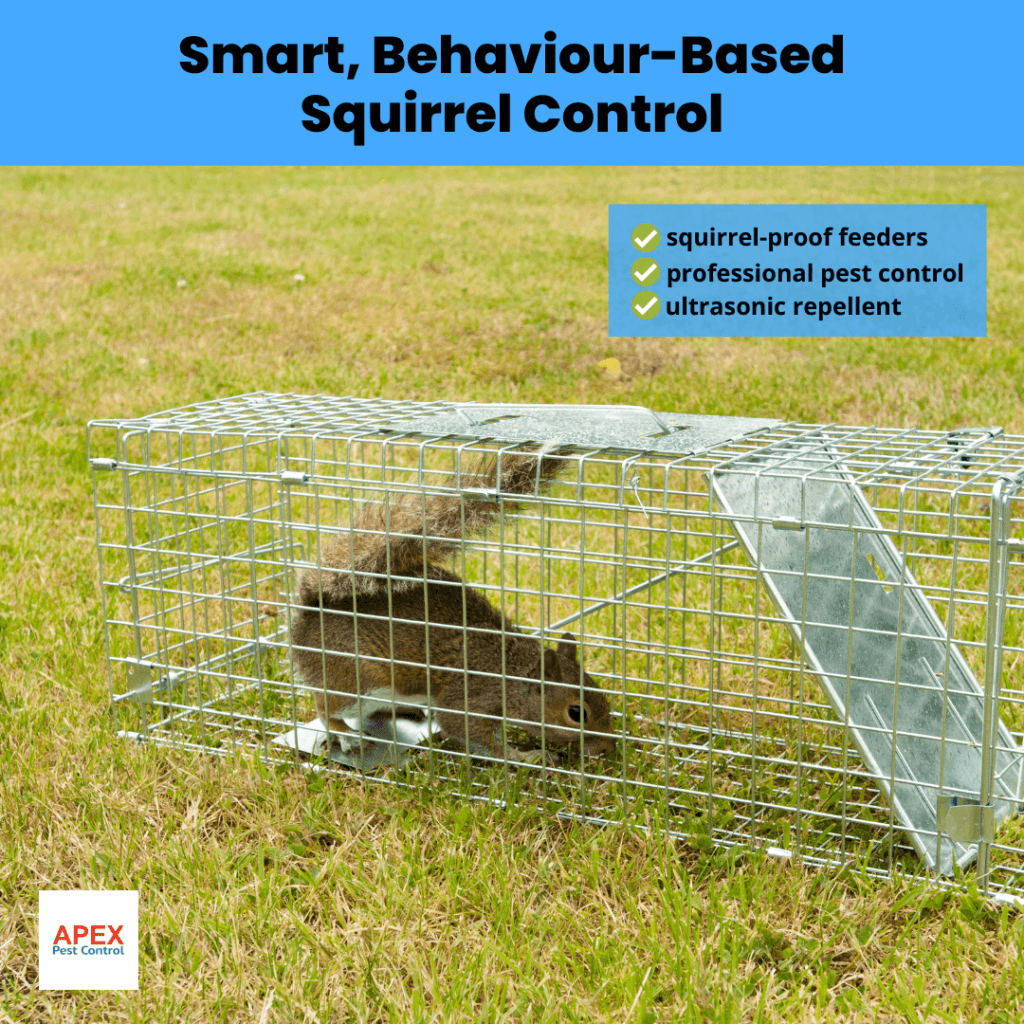Squirrel Behaviour: The Key to Effective Grey Squirrel Pest Control in the UK
Grey squirrels are a familiar sight in UK woodlands, parks, and urban gardens. While they may appear charming, understanding their behaviour is essential for humane, legal, and effective pest control.
This comprehensive guide explores grey squirrel species, habits, habitats, and the behavioural patterns that shape compliant pest management strategies in the UK.
Discover the legal framework for squirrel baiting and removal in the UK with our in-depth guide, covering approved methods, compliance standards, and best practices for humane pest control.
Know Your Squirrel: Species and Habitats

Types of Squirrels in the UK
- Eastern Grey Squirrel (Sciurus carolinensis): Non-native and invasive, the grey squirrel has become dominant across much of the UK, outcompeting the native red squirrel.
- Red Squirrel (Sciurus vulgaris): Native but now endangered, mainly due to competition and disease spread by grey squirrels.
- Other Species: Flying squirrels, prairie dogs, and similar rodents are not found in the UK.
Where Do Squirrels Live?
Grey squirrels thrive in areas offering both food and shelter, such as:
- Deciduous woodlands and mixed forests
- Urban parks, rooftops, lofts, and gardens
- Tree canopies, loft spaces, and chimneys (for nesting, known as “dreys”)
Did you know?
Grey squirrels build both permanent and temporary dreys, often in high tree forks or
roof spaces.
Behavioural Patterns That Matter

Daily Routine
Grey squirrels are diurnal—active during daylight. Their typical day includes:
- Early morning foraging
- Midday resting
- Late afternoon food storage and return to nests
Feeding and Caching
Grey squirrels are opportunistic foragers, eating:
- Nuts (acorns, hazelnuts)
- Seeds, bark, fruit, fungi
- Occasionally bird eggs and insects
They cache food by burying it in the ground or hiding it in tree hollows for winter
retrieval.
Communication and Signals
Squirrels communicate using:
- High-pitched alarm calls to warn of predators
- Tail flicking to signal aggression, fear, or alertness
“Squirrel alarm calls are more complex than previously thought. They can communicate urgency, type of threat, and even direction.” — Wildlife Online
Social and Mating Behaviour
- Largely solitary except during mating season
- Dominance hierarchies influence territory and food access
- Females raise young (called “kits” or “pups”) alone, usually in spring and summer
Why Grey Squirrels Are a Pest in the UK
| Impact Area | Description |
|---|---|
| Ecological |
|
| Economic |
|
| Structural Damage |
|
| Garden & Agricultural Damage |
|
| Wildlife Impact |
|
| Noise & Nuisance |
|
Legal Considerations for Squirrel Control
Grey squirrels are listed under the Invasive Alien Species (Enforcement and Permitting) Order 2019. In the UK:
- It is illegal to release a trapped grey squirrel. Any captured grey squirrel must be humanely dispatched.
- Professional assistance is strongly recommended to ensure legal compliance and humane treatment.
Source: BPCA: Grey Squirrel Control
Physical Traits and Urban Adaptations

Grey squirrels are well adapted for both rural and urban environments:
- Strong hind legs for jumping
- Sharp claws for climbing
- Constantly growing incisors for gnawing
- Long, bushy tail for balance and warmth
Urban settings offer abundant food and nesting opportunities, making lofts and bird feeders especially attractive.
Smart, Behaviour-Based Squirrel Control

Why Behaviour Matters
Effective squirrel control requires understanding:
- When they are active: Daylight hours
- Where they nest: High, quiet areas like lofts and trees
- What they eat and hoard: Nuts, seeds, suet
This knowledge helps you plan strategic, humane, and legally compliant interventions.
Prevention Tips
Seal roof gaps and soffits larger than 25mm
- Install metal mesh and exclusion devices
- Prune overhanging tree limbs
- Use squirrel-proof bird feeders
- Keep gardens tidy to reduce attractants
DIY vs Professional Control
| Method | Pros | Cons |
|---|---|---|
| DIY Deterrents |
|
|
| Professional Pest Control |
|
|
“Without addressing entry points and behaviour, squirrel control is a losing battle.” — BPCA Certified Technician
Squirrel Facts: Commonly Asked Questions
How long do grey squirrels live?
Most wild grey squirrels live 2–4 years, though they can reach 10–12 years in ideal conditions.
Can squirrels swim?
Yes, grey squirrels can swim, using their tails for steering, though they generally avoid water.
What are baby squirrels called?
They are known as “kits” or “pups.”
Are squirrels nocturnal?
No, grey squirrels are diurnal and active during the day.
What is a group of squirrels called?
A group is called a “scurry” or “dray.”
How do I know if I have squirrels in my loft?
Look for gnawed timbers, rodent droppings, and daytime scratching noises.
Can I remove a squirrel myself in the UK?
You must comply with UK law: it is illegal to release a captured grey squirrel. Humane dispatch is required, and professional help is strongly advised.
What’s the best deterrent for garden squirrels?
Use capsaicin-based sprays, ultrasonic repellents, and squirrel-proof feeders.
Summary and Final Thoughts
Understanding grey squirrel behaviour is crucial for legal, effective, and ethical pest control in the UK. By recognising their routines, social habits, and adaptability, you can take informed steps to protect your home, garden, and native wildlife.
For expert, legally compliant help, contact Apex Pest Control in South Yorkshire for a BPCA-certified and NPTA registered pest control professional.

Tony Johnson, Founder & Lead Technician at Apex Pest Control, is a BPCA and NPTA accredited pest management expert with over 35 years’ hands-on experience. Tony specialises in Integrated Pest Management and ensures all services comply with UK pest legislation, including the Wildlife and Countryside Act 1981 and COSHH Regulations 2002. His commitment to continual learning and adapting to industry best practices means clients receive effective, safe solutions for pests affecting homes and businesses across South Yorkshire. Tony’s dedication to professional standards, ethical treatment methods, and local expertise has made him a trusted partner for pest control and prevention.
-
BPCA & NPTA accredited | CHAS certified
-
Committed to UK pest law compliance & safety
-
Focused on effective, ethical pest management for South Yorkshire


